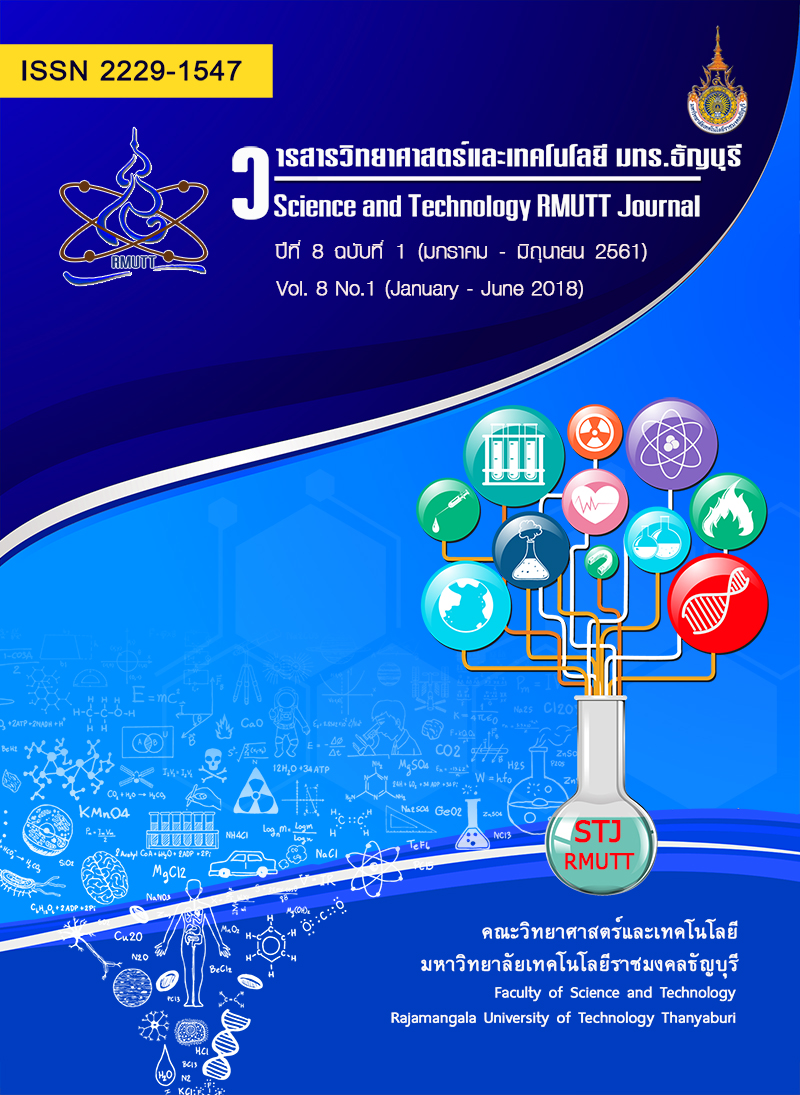Antibacterial activity of medicinal plant extracts against some pathogenic bacteria causing skin diseases
Main Article Content
Abstract
This research was aimed to study antibacterial activities of 4 local medicinal plant extracts against 3 species of bacteria causing skin diseases i.e. Pseudomonas aeruginosa ATCC 27853, Staphylococcus aureus ATCC 25923 and methicillin resistant Staphylococcus aureus (MRSA). Ethanol and aqueous crude extracts of each plant were prepared to investigate the antibacterial activity by agar well diffusion assay and broth dilution method. It was found that the ethanol extract of Houttuynia cordata showed highest activity against S. aureus ATCC 25923 and MRSA with MIC of 15.63 and 7.81 mg/ml and MBC of 31.25 and 62.50 mg/ml, respectively. Moreover, the ethanolic extract of Tiliacora triandra represented highest growth inhibitory activity on MRSA and P. aeruginosa ATCC 27853, at MIC of 7.81 mg/ml and MBC of 125 mg/ml. The cytotoxicity effect of all local medicinal plant extracts on the Vero cells showed that the ethanol extract of Houttuynia cordata and Gymnema inodorum had the highest toxic effect with CD50 of 0.891 mg/ml.
Article Details
References
Nasri H. and Shirzad H. Toxicity and safety of medicinal plants. J. Herbmed. Plarmacol. 2013. 2(2): 21-22.
Chaichompool A. and Thongwai N. Growth inhibition of some pathogenic bacteria by local medicinal plant extracts. Proceeding of the 8th Kasetsart University Kamphaeng Saen Campus conference, Thailand. 8-9 December 2011, 792-801.
Chansakaow S., Leelapornpisid P., Yosprasit K. and Tharavichitkul P. Antibacterial activity of Thai medicinal plant extracts on the skin infectious microorganisms. In III WOCMAP Congress on Medicinal and Aromatic Plants. Targeted Screening of MAPs, Economics & Law. 2003. 678(4) : 153-157.
Tsai T., Wu W., Tseng J.T. and Tsai P.J. In vitro antimicrobial and anti-inflammatory effects of herbs against Propionibacterium acnes. Food Chem. 2010. 119(3) : 964-968.
Kamonwannasit S., Nantapong N., Kumkrai P., Luecha P., Kupittayanant S. and Chudapongse N. Antibacterial activity of Aquilaria crassna leaf extract against Staphylococcus epidermidis by disruption of cell wall. Ann. Clin. Microbiol. Antimicrob. 2013: 12(1): 20.
Ismail Y., Wedyan M., Al-Zu'abe M. and Abderrahman S. Antimicrobial activity of Rubia cordifolia: methods to determine antimicrobial activity. J. Med. Plants Res. 2016. 10(8): 457-462.
Rios J.L, Recio MC and Villar A. Screening methods for natural products with antimicrobial activity. J. Ethnopharmacol. 1988. 23(2): 127-49.
Ali A.M., Mackeen M.M. and El - Sharkawy S.H. Antiviral and cytotoxic activities of some plants used in Malaysian indigenous medicine. Pertanika J. Trop. Agric. Sci. 1996. 19 (2-3): 129-136.
Marshall N.J., Goodwin C.J. and Holt S.J. A critical assessment of the use of microculture tetrazolium assays to measure cell growth and function. J. Plant Growth Regul. 1995. 5(2): 69-84.
Finney D.J. Probit Analysis. 3rd Ed., Cambridge University Press, London. 1971.
Martinez de Tejada G., Sánchez-Gómez S., Rázquin-Olazaran I., Kowalski I., Kaconis Y., Heinbockel L., Andrä J., Schürholz T., Hornef M., Dupont A., Garidel P., Gutsmann T., David S.A., Brandenburg K. and Garidel, P. Bacterial cell wall compounds as promising targets of antimicrobial agents I. Antimicrobial peptides and lipopolyamines. Curr. Drug Targets. 2012. 13(9) : 1121-1130.
Witkowska A.M., Hickey D.K., Alonso-Gomez M. and Wilkinson M. Evaluation of antimicrobial activities of commercial herb and spice extracts against selected food-borne bacteria. J. Food Res. 2013. 2(4) : 37-54.
Gberikon G.M., Adeoti I.I. and Aondoackaa A.D. Effect of ethanol and aqueous solutions as extraction solvents on phytochemical screening and antibacterial activity of fruit and stem bark extracts of Tetrapleura tetrapteraon Streptococcus salivarus and Streptococcus mutans. Int. J. Curr. Microbiol. App. Sci. 2015. 4(5): 404-410.
Fu J., Dai L., Lin Z. and Lu H. Houttuynia cordata Thunb: a review of phytochemistry and pharma- cology and quality control. Chin. Med. J. 2013. 4(3): 101.
Ahmed S., Borah M. and Das S. A comparative study of the antibacterial activity of the ethanolic extracts of Phlogacanthus Thyrsifloru., Houttuynia cordata, Curcuma caesia and Syzygium jumbos. Int. J. Pharm. 2012. 3(9) : 282-285.
Naibaho N.M., Kerdchoechuen O. and Laohankunjit N. Physico-chemical properties of plant extracts from Yanang (Tiliacora triandra) leaves. J. Agric. Sci. 2012. 43(2): 533-536.
Klinklan K., Kerdchoechuen O. and Laohankunjit N. Volatile compounds and antibacterial activity of starch foam coated herbs essential oils. J. Agric.
Sci. 2014. 45(2): 705-708.
Rahman A.F. and Asad M. Chemical and biological investigations of the leaves of Gynura procumbens. Int. J. Biosci. 2013. 3(4): 36-43.
Xie P. Skin care creams containing Gynura Extracts. CN. Patent No. 101032458. Beijing: State Intellectual Property Office of the P.R.C. 2007.
Tan H.L., Chan K.G., Pusparajah P., Lee L.H., and Goh B.H. Gynura procumbens: an overview of the biological activities. Front. Pharmacol. 2016. 7: 52.


